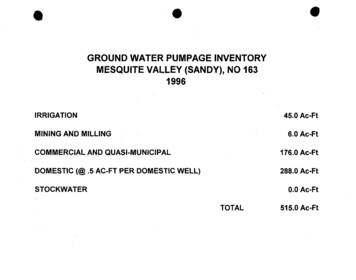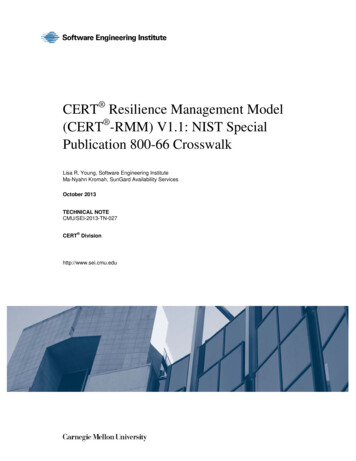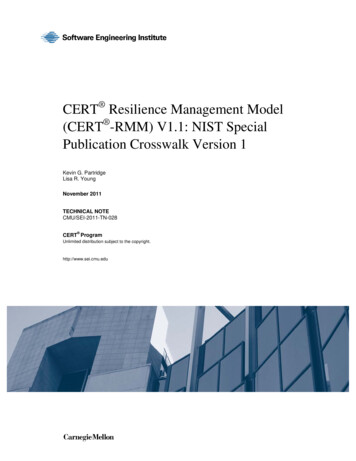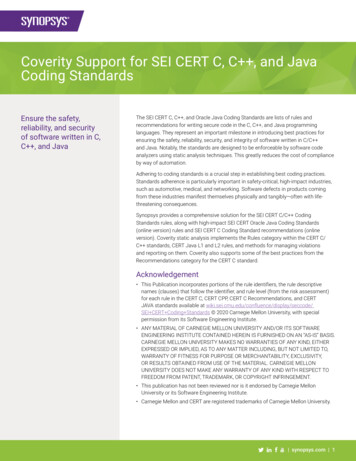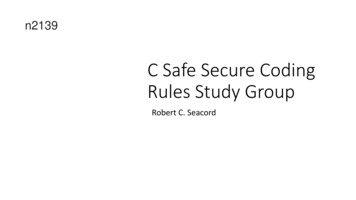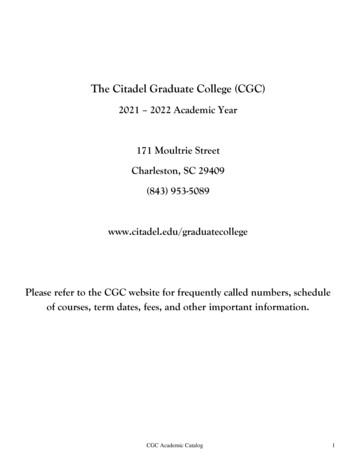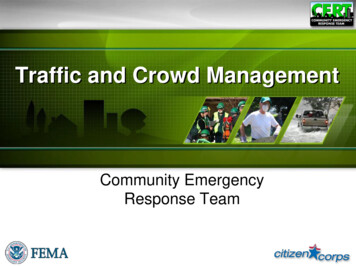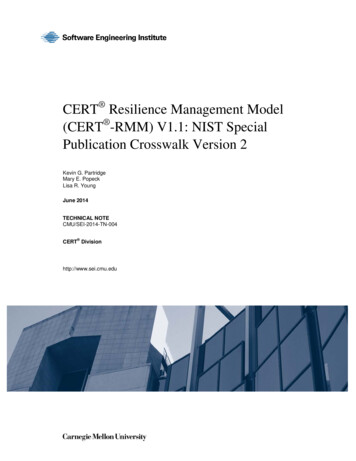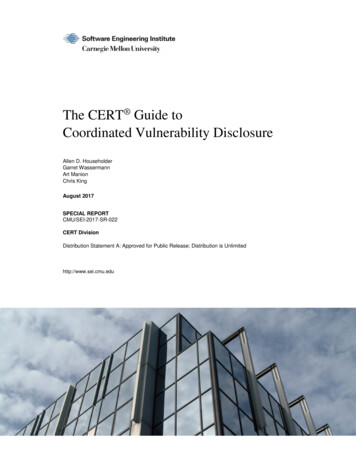
Transcription
The CERT Guide toCoordinated Vulnerability DisclosureAllen D. HouseholderGarret WassermannArt ManionChris KingAugust 2017SPECIAL REPORTCMU/SEI-2017-SR-022CERT DivisionDistribution Statement A: Approved for Public Release; Distribution is Unlimitedhttp://www.sei.cmu.edu
Copyright 2017 Carnegie Mellon University. All Rights Reserved.This material is based upon work funded and supported by the Department of Defense under ContractNo. FA8702-15-D-0002 with Carnegie Mellon University for the operation of the Software Engineering Institute, a federally funded research and development center.The view, opinions, and/or findings contained in this material are those of the author(s) and should notbe construed as an official Government position, policy, or decision, unless designated by other documentation.This report was prepared for the SEI Administrative Agent AFLCMC/AZS 5 Eglin Street HanscomAFB, MA 01731-2100NO WARRANTY. THIS CARNEGIE MELLON UNIVERSITY AND SOFTWARE ENGINEERINGINSTITUTE MATERIAL IS FURNISHED ON AN "AS-IS" BASIS. CARNEGIE MELLONUNIVERSITY MAKES NO WARRANTIES OF ANY KIND, EITHER EXPRESSED OR IMPLIED,AS TO ANY MATTER INCLUDING, BUT NOT LIMITED TO, WARRANTY OF FITNESS FORPURPOSE OR MERCHANTABILITY, EXCLUSIVITY, OR RESULTS OBTAINED FROM USEOF THE MATERIAL. CARNEGIE MELLON UNIVERSITY DOES NOT MAKE ANYWARRANTY OF ANY KIND WITH RESPECT TO FREEDOM FROM PATENT, TRADEMARK,OR COPYRIGHT INFRINGEMENT.[DISTRIBUTION STATEMENT A] This material has been approved for public release and unlimiteddistribution. Please see Copyright notice for non-US Government use and distribution.Internal use:* Permission to reproduce this material and to prepare derivative works from this materialfor internal use is granted, provided the copyright and “No Warranty” statements are included with allreproductions and derivative works.External use:* This material may be reproduced in its entirety, without modification, and freely distributed in written or electronic form without requesting formal permission. Permission is required for anyother external and/or commercial use. Requests for permission should be directed to the Software Engineering Institute at permission@sei.cmu.edu.* These restrictions do not apply to U.S. government entities.DM17-0508CMU/SEI-2017-SR-022 SOFTWARE ENGINEERING INSTITUTE CARNEGIE MELLON UNIVERSITYDistribution Statement A: Approved for Public Release; Distribution is Unlimited
Table of ContentsPrefaceviiAcknowledgmentsxExecutive Summaryxi1Introduction1.1 Coordinated Vulnerability Disclosure is a Process, Not an Event1.2 CVD Context and Terminology Notes1.2.1 Vulnerability1.2.2 Exploits, Malware, and Incidents1.2.3 Vulnerability Response (VR)1.2.4 Vulnerability Discovery1.2.5 Coordinated Vulnerability Disclosure1.2.6 Vulnerability Management (VM)1.2.7 Products and Instances1.2.8 Incident vs. Vulnerability Response1.3 Why Coordinate Vulnerability Disclosures?1.4 Previewing the Remainder of this Document11222333566672Principles of Coordinated Vulnerability Disclosure2.1 Reduce Harm2.2 Presume Benevolence2.3 Avoid Surprise2.4 Incentivize Desired Behavior2.5 Ethical Considerations2.5.1 Ethics in Related Professional Societies2.5.2 Journalism Ethics2.6 Process Improvement2.6.1 CVD and the Security Feedback Loop2.6.2 Improving the CVD Process Itself2.7 CVD as a Wicked Problem8891010111111121213133Roles in CVD3.1 Finder3.2 Reporter3.3 Vendor3.3.1 Vendor as the Introducer of Vulnerabilities3.3.2 Vendor Vulnerability Response Process3.3.3 Vendor Sub-Roles3.4 Deployer3.4.1 Deployer Vulnerability Response Process3.5 Coordinator3.5.1 Computer Security Incident Response Team (CSIRT)3.5.2 CSIRT with National Responsibility3.5.3 Product Security Incident Response Team (PSIRT)3.5.4 Security Research Organizations3.5.5 Bug Bounties and Commercial Brokers3.5.6 Information Sharing and Analysis Organizations (ISAOs) and Centers (ISACs)3.5.7 Reasons to Engage a Coordinator3.6 Other Roles and SEI-2017-SR-022 SOFTWARE ENGINEERING INSTITUTE CARNEGIE MELLON UNIVERSITYDistribution Statement A: Approved for Public Release; Distribution is Unlimitedi
3.6.13.6.23.6.33.6.43.6.53.6.6UsersIntegratorCloud and Application Service ProvidersInternet of ThingsMobile Platforms and ApplicationsGovernments2626262627274Phases of CVD4.1 Discovery4.1.1 Why Look for Vulnerabilities?4.1.2 Avoid Unnecessary Risk in Finding Vulnerabilities4.2 Reporting4.2.1 Create Secure Channels for Reporting4.2.2 Encourage Reporting4.2.3 Reduce Friction in the Reporting Process4.2.4 Providing Useful Information4.3 Validation and Triage4.3.1 Validating Reports4.3.2 Triage Heuristics4.4 Remediation4.4.1 Isolating the Problem4.4.2 Fix the Problem4.4.3 Mitigate What You Cannot Fix4.5 Gaining Public Awareness4.5.1 Prepare and Circulate a Draft4.5.2 Publishing4.5.3 Vulnerability Identifiers Improve Response4.5.4 Where to Publish4.6 Promote Deployment4.6.1 Amplify the Message4.6.2 Post-Publication 404041415Process Variation Points5.1 Choosing a Disclosure Policy5.2 Disclosure Choices5.3 Two-Party CVD5.4 Multiparty CVD5.4.1 Multiple Finders / Reporters5.4.2 Complicated Supply Chains5.4.3 Mass Notifications for Multiparty CVD5.5 Response Pacing and Synchronization5.5.1 When One Party Wants to Release Early5.5.2 Communication Topology5.5.3 Motivating Synchronized Release5.6 Maintaining Pre-Disclosure Secrecy5.6.1 Coordinating Further Downstream5.6.2 Do You Include Deployers?5.6.3 Complex Communications Reduce Trust5.7 Disclosure Timing5.7.1 Conference Schedules and Disclosure Timing5.7.2 Vendor Reputation and Willingness to Cooperate5.7.3 Declarative Disclosure Policies Reduce Uncertainty5.7.4 Diverting from the Plan5.7.5 Releasing Partial Information Can Help 05051CMU/SEI-2017-SR-022 SOFTWARE ENGINEERING INSTITUTE CARNEGIE MELLON UNIVERSITYDistribution Statement A: Approved for Public Release; Distribution is Unlimitedii
6Troubleshooting CVD6.1 Unable to Find Vendor Contact6.2 Unresponsive Vendor6.3 Somebody Stops Replying6.4 Intentional or Accidental Leaks6.5 Independent Discovery6.6 Active Exploitation6.7 Relationships that Go Sideways6.8 Hype, Marketing, and Unwanted Attention6.8.1 The Streisand Effect6.9 What to Do When Things Go Wrong6.9.1 Keep Calm and Carry On6.9.2 Avoid Legal Entanglements6.9.3 Recognize the Helpers6.9.4 Consider Publishing Early6.9.5 Engage a Third-Party Coordinator6.9.6 Learn from the tional Considerations7.1 Tools of the Trade7.1.1 Secure Communication Channels7.1.2 Contact Management7.1.3 Bug Bounty Platforms7.1.4 Case and Bug Tracking7.1.5 Code and System Inventories7.1.6 Test Bench and Virtualization7.2 Operational Security7.2.1 PGP/GPG Key Management7.2.2 Handling Sensitive Data7.2.3 Don’t Automatically Trust Reports7.3 CVD Staffing Considerations7.3.1 Beware Analyst Burnout58585860606161626363656566668Open Problems in CVD8.1 Vulnerability IDs and DBs8.1.1 On the Complexities of Vulnerability Identity8.1.2 What CVE Isn’t8.1.3 Every Vulnerability Database Makes Choices8.1.4 Where We Are vs. Where We Need to Be8.1.5 Vulnerability IDs, Fast and Slow8.1.6 A Path Toward VDB Interoperability8.1.7 Looking Ahead8.2 IoT and CVD8.2.1 Black Boxes8.2.2 Unrecognized Subcomponents8.2.3 Long-Lived and Hard-to-Patch8.2.4 New Interfaces Bring New Threats8.2.5 Summarizing the IoT’s Impact on ndix A – On the Internet of Things and Vulnerability Analysis76Appendix B – Traffic Light Protocol81CMU/SEI-2017-SR-022 SOFTWARE ENGINEERING INSTITUTE CARNEGIE MELLON UNIVERSITYDistribution Statement A: Approved for Public Release; Distribution is Unlimitediii
Appendix C – Sample Vulnerability Report Form83Appendix D – Sample Vulnerability Disclosure Document85Appendix E – Disclosure Policy Templates87Bibliography89CMU/SEI-2017-SR-022 SOFTWARE ENGINEERING INSTITUTE CARNEGIE MELLON UNIVERSITYDistribution Statement A: Approved for Public Release; Distribution is Unlimitediv
List of FiguresFigure 1:CVD Role Relationships15Figure 2:Coordination Communication Topologies47CMU/SEI-2017-SR-022 SOFTWARE ENGINEERING INSTITUTE CARNEGIE MELLON UNIVERSITYDistribution Statement A: Approved for Public Release; Distribution is Unlimitedv
List of TablesTable 1:I Am the Cavalry’s Finder / Reporter MotivationsTable 2:Mapping CVD Roles to PhasesCMU/SEI-2017-SR-022 SOFTWARE ENGINEERING INSTITUTE CARNEGIE MELLON UNIVERSITYDistribution Statement A: Approved for Public Release; Distribution is Unlimited930vi
PrefaceSoftware and software-based products have vulnerabilities. Left unaddressed, those vulnerabilitiesexpose to risk the systems on which they are deployed and the people who depend on them. In order for vulnerable systems to be fixed, those vulnerabilities must first be found. Once found, thevulnerable code must be patched or configurations must be modified. Patches must be distributedand deployed. Coordinated Vulnerability Disclosure (CVD) is a process intended to ensure thatthese steps occur in a way that minimizes the harm to society posed by vulnerable products. Thisguide provides an introduction to the key concepts, principles, and roles necessary to establish asuccessful CVD process. It also provides insights into how CVD can go awry and how to respondwhen it does so.In a nutshell, CVD can be thought of as an iterative process that begins with someone finding avulnerability, then repeatedly asking “what should I do with this information?” and “who elseshould I tell?” until the answers are “nothing,” and “no one.” But different parties have differentperspectives and opinions on how those questions should be answered. These differences are whatled us to write this guide.The CERT Coordination Center has been coordinating the disclosure of vulnerability reports sinceits inception in 1988. Although both our organization and the Internet have grown and changed inthe intervening decades, many of the charges of our initial charter remain central to our mission:to facilitate communication among experts working to solve security problems; to serve as a central point for identifying and correcting vulnerabilities in computer systems; to maintain close tieswith research activities and conduct research to improve the security of existing systems; and toserve as a model for other incident response organizations.If we have learned anything in nearly three decades of coordinating vulnerability disclosures atthe CERT/CC, it is that there is no single right answer to many of the questions and controversiessurrounding the disclosure of information about software and system vulnerabilities. In the traditional computing arena, most vendors and researchers have settled into a reasonable rhythm of allowing the vendor some time to fix vulnerabilities prior to publishing a vulnerability report morewidely. Software as a service (SAAS) and software distributed through app stores can often fixand deploy patches to most customers quickly. On the opposite end of the spectrum, we findmany Internet of Things (IoT) and embedded device vendors for whom fixing a vulnerabilitymight require a firmware upgrade or even physical replacement of affected devices, neither ofwhich can be expected to happen quickly (if at all). This diversity of requirements forces vendorsand researchers alike to reconsider their expectations with respect to the timing and level of detailprovided in vulnerability reports. Coupled with the proliferation of vendors who are relative novices at internet-enabled devices and are just becoming exposed to the world of vulnerability research and disclosure, the shift toward IoT can be expected to reinvigorate numerous disclosuredebates as the various stakeholders work out their newfound positions.Here’s just one example: in 2004, it was considered controversial [1] when the CERT/CC advisedusers to “use a different browser” in response to a vulnerability in the most popular browser of theCMU/SEI-2017-SR-022 SOFTWARE ENGINEERING INSTITUTE CARNEGIE MELLON UNIVERSITYDistribution Statement A: Approved for Public Release; Distribution is Unlimitedvii
day (VU#713878) [2]. However, consider the implications today if we were to issue similar advice: “use a different phone,” “drive a different car,” or “use a different bank.” If those phrasesgive you pause (as they do us), you have recognized how the importance of this issue has grown.We often find that vendors of software-centric products are not prepared to receive and handlevulnerability reports from outside parties, such as the security research community. Many alsolack the ability to perform their own vulnerability discovery within their development lifecycles.These difficulties tend to arise from one of two causes: (a) the vendor is comparatively small ornew and has yet to form a product security incident response capability or (b) the vendor has deepengineering experience in its traditional product domain but has not fully incorporated the effectof network enabling its products into its engineering quality assurance practice. Typically, vendors in the latter group may have very strong skills in safety engineering or regulatory compliance, yet their internet security capability is lacking.Our experience is that many novice vendors are surprised by the vulnerability disclosure process.We frequently find ourselves having conversations that rehash decades of vulnerability coordination and disclosure conversations with vendors who appear to experience something similar to theKübler-Ross stages of grief (denial, anger, bargaining, depression, and acceptance) during theprocess.Furthermore, we have observed that overly optimistic threat models are de rigueur among IoTproducts. Many IoT products are developed with what can only be described as naïve threat models that drastically underestimate the hostility of the environments into which the product will bedeployed.Even in cases where developers are security-knowledgeable, often they are composing systemsout of components or libraries that may not have been developed with the same degree of securityconsideration. This weakness is especially pernicious in power- or bandwidth-constrained products and services where the goal of providing lightweight implementations can supersede the needto provide a minimum level of security. We believe this is a false economy that only defers amuch larger cost when the product or service has been deployed, vulnerabilities are discovered,and remediation is difficult.We anticipate that many of the current gaps in security analysis knowledge and tools surroundingthe emergence of IoT devices will begin to close over the next few years. However, it may besome time before we can fully understand how the products already available today, let alone tomorrow, will impact the security of the networks onto which they are placed. The scope of theproblem does not appear to contract any time soon.We already live in a world where mobile devices outnumber traditional computers, and IoT standsto dwarf mobile computing in terms of the sheer number of devices within the next few years. Asvulnerability discovery tools and techniques evolve into this space, so must our tools and processes for coordination and disclosure. Assumptions built into many vulnerability handling processes about disclosure timing, coordination channels, development cycles, scanning, patching,and so forth will need to be reevaluated in the light of hardware-based systems that are likely todominate the future internet.CMU/SEI-2017-SR-022 SOFTWARE ENGINEERING INSTITUTE CARNEGIE MELLON UNIVERSITYDistribution Statement A: Approved for Public Release; Distribution is Unlimitedviii
About This ReportThis is not a technical document. You will not learn anything new about fuzzing, debugging, ROPgadgets, exploit mitigations, heap spraying, exception handling, or anything about how computerswork by reading this report. What you will learn is what happens to that knowledge and how itsdissemination is affected by the human processes of communications and social behavior in thecontext of remediating security vulnerabilities.This is not a history. We won’t spend much time at all on the history of disclosure debates, or thefine details of whether collecting or dropping zero-days is always good or always bad. We willtouch on these ideas only insofar as they intersect with the current topic of coordinated vulnerability disclosure.This is not an indictment. We are not seeking to place blame on one party or another for the success or failure of any given vulnerability disclosure process. We’ve seen enough disclosure casesto know that people make choices based on their own values coupled with their assessment of asituation, and that even in cases where everyone agrees on what should happen, mistakes and unforeseeable events sometimes alter the trajectory from the plan.This is not a standard. We assert no authority to bless the information here as “the way thingsought to be done.” In cases where standards exist, we refer to them, and this report is informed bythem. In fact, we’ve been involved in creating some of them. But the recommendations made inthis report should not be construed as “proper,” “correct,” or “ideal” in any way. As we’ll show,disclosing vulnerabilities presents a number of difficult challenges, with long-reaching effects.The recommendations found here do, however, reflect our observation over the past few decadesof what works (and what doesn’t) in the pursuit of reducing the vulnerability of software and related products.This is a summary of what we know about a complex social process that surrounds humans tryingto make the software and systems they use more secure. It’s about what to do (and what not to)when you find a vulnerability, or when you find out about a vulnerability. It’s written for vulnerability analysts, security researchers, developers, and deployers; it’s for both technical staff andtheir management alike. While we discuss a variety of roles that play a part in the process, we intentionally chose not to focus on any one role; instead we wrote for any party that might find itselfengaged in coordinating a vulnerability disclosure.We wrote it in an informal tone to make the content more approachable, since many readers’ interest in this document may have been prompted by their first encounter with a vulnerability in aproduct they created or care about. The informality of our writing should not be construed as alack of seriousness about the topic, however.In a sense, this report is a travel guide for what might seem a foreign territory. Maybe you’vepassed through once or twice. Maybe you’ve only heard about the bad parts. You may be uncertain of what to do next, nervous about making a mistake, or even fearful of what might befall you.If you count yourself as one of those individuals, we want to reassure you that you are not alone;you are not the first to experience events like these or even your reaction to them. We’re locals.We’ve been doing this for a while. Here’s what we know.CMU/SEI-2017-SR-022 SOFTWARE ENGINEERING INSTITUTE CARNEGIE MELLON UNIVERSITYDistribution Statement A: Approved for Public Release; Distribution is Unlimitedix
AcknowledgmentsThe material in the CERT Guide to Coordinated Vulnerability Disclosure inherits from 29 yearsof analyzing vulnerabilities and navigating vulnerability disclosure issues at the CERT Coordination Center (CERT/CC). While a few of us may be the proximate authors of the words you arereading, many of the ideas these words represent have been bouncing around at CERT for years inone brain or another. We’d like to acknowledge those who contributed their part to this endeavor,whether knowingly or not:Jared Allar, Jeff Carpenter, Cory Cohen, Roman Danyliw, Will Dormann, Chad Dougherty,James T. Ellis, Ian Finlay, Bill Fithen, Jonathan Foote, Jeff Gennari, Ryan Giobbi, Jeff Havrilla,Shawn Hernan, Allen Householder, Chris King, Dan Klinedinst, Joel Land, Jeff Lanza, ToddLewellen, Navika Mahal, Art Manion, Joji Montelibano, Trent Novelly, Michael Orlando, RichPethia, Jeff Pruzynski, Robert Seacord, Stacey Stewart, David Warren, and Garret Wassermann.CMU/SEI-2017-SR-022 SOFTWARE ENGINEERING INSTITUTE CARNEGIE MELLON UNIVERSITYDistribution Statement A: Approved for Public Release; Distribution is Unlimitedx
Executive SummarySoftware-based products and services have vulnerabilities—conditions or behaviors that allow theviolation of an explicit or implicit security policy. This should come as no surprise to those familiar with software. What many find surprising nowadays is just how many products and servicesshould be considered software based. The devices we depend on to communicate and coordinateour lives, transport us from place to place, and keep us healthy have in recent years become moreand more connected both to each other and to the world at large. As a result, society has developed an increasing dependence on software-based products and services along with a commensurate need to address the vulnerabilities that inevitably accompany them.Adversaries take advantage of vulnerabilities to achieve goals at odds with the developers, deployers, users, and other stakeholders of the systems we depend on. Notifying the public that aproblem exists without offering a specific course of action to remediate it can result in giving anadversary the advantage while the remediation gap persists. Yet there is no optimal formula forminimizing the potential for harm to be done short of avoiding the introduction of vulnerabilitiesin the first place. In short, vulnerability disclosure appears to be a wicked problem. 1Coordinated Vulnerability Disclosure (CVD) is a process for reducing adversary advantage whilean information security vulnerability is being mitigated. CVD is a process, not an event. Releasinga patch or publishing a document are important events within the process, but do not define it.CVD participants can be thought of as repeatedly asking these questions: What actions should Itake in response to knowledge of this vulnerability in this product? Who else needs to know what,and when do they need to know it? The CVD process for a vulnerability ends when the answers tothese questions are nothing, and no one.CVD should not be confused with Vulnerability Management (VM). VM encompasses the process downstream of CVD, once the vulnerability has been disclosed and deployers must take action to respond. Section 1 introduces the CVD process and provides notes on relevant terminology.Principles of CVDSection 2 covers principles of CVD, including the following: Reduce Harm –Decrease the potential for damage by publishing vulnerability information;using exploit mitigation technologies; reducing days of risk; releasing high-quality patches;and automating vulnerable host identification and patch deployment. Presume Benevolence – Assume that any individual who has taken the time and effort toreach out to a vendor or a coordinator to report an issue is likely benevolent and sincerelywishes to reduce the harm of the vulnerability.1The definition of a wicked problem based on an article by Rittel and Webber [41] is given in Section 2.7.CMU/SEI-2017-SR-022 SOFTWARE ENGINEERING INSTITUTE CARNEGIE MELLON UNIVERSITYDistribution Statement A: Approved for Public Release; Distribution is Unlimitedxi
Avoid Surprise – Surprise tends to increase the risk of a negative outcome from the disclosure of a vulnerability and should be avoided. Incentivize Desired Behavior – It’s usually better to reward good behavior than try to punish bad behavior. Incentives are important as they increase the likelihood of future cooperation between security researchers and organizations. Ethical Considerations – A number of ethical guidelines from both technical and journalistic professional societies can find application in the CVD process. Process Improvement – Participants in the CVD process should learn from their experienceand improve their process accordingly. CVD can also provide important feedback to an organization’s Software Development Lifecycle (SDL). CVD as a Wicked Problem – As we’ve already mentioned, vulnerability disclosure is amultifaceted problem for which there appear to be no “right” answers, only “better” or“worse” solutions in a given context.Roles in CVDCVD begins with finding vulnerabilities and ends with the deployment of patches or mitigations.As a result, several distinct roles and stakeholders are involved in the CVD process. These includethe following: Finder (Discoverer) – the individual or organization that identifies the vulnerability Reporter – the individual or organization that notifies the vendor of the vulnerability Vendor – the individual or organization that created or maintains the product that is vulnerable Deployer – the individual or organization that must deploy a patch or take other remediationaction Coordinator – an individual or organization that facilitates the coordinated response processIt is possible and often the case that individuals and organizations play multiple roles. For example, a cloud service provider might act as both vendor and deployer, while a researcher might actas both finder and reporter. A vendor may also be both a deployer and a coordinator.Reasons to engage a coordinator include reporter inexperience, reporter capacity, multiparty coordination cases, disputes among CVD participants, and vulnerabilities having significant infrastructure impacts.Users, integrators, cloud and application service providers, Internet of Things (IoT) and mobilevendors, and governments are also stakeholders in the CVD process. We cover these roles andstakeholders in more detail in Section 3.Phases of CVDThe CVD process can be broadly defined as a set of phases, as described in Section 4. Althoughthese phases may sometimes occur out of order, or even recur within the handling of a single vulnerability case (for example, each recipient of a case may need to independently validate a report),they often happen in the following order:CMU/SEI-2017-SR-022 SOFTWARE ENGINEERING INSTITUTE CARNEGIE MELLON UNIVERSITYDistribution Statement A: Approved for Public Release; Distribution is Unlimitedxii
Discovery – Someone discovers a vulnerability in a product. Reporting – The product’s vendor or a third-party coordinator receives a vulnerability report. Validation and Triage – The receiver of a report validates it to ensure accuracy before prioritizing it for further action. Remediation – A remediation plan (ideally a software patch, but could also be other mechanisms) is developed and tested. Public Awareness – The vulnerability and its remediation plan is disclosed to the public. Deployment – The remediation is applied to deployed systems.CVD Process VariationAs an endeavor of human coordination at both the individual and organization levels, the CVDprocess can vary from participant to participant, over time, and in varying contexts. Some pointsof variation include those below: Choosing a disclosure policy – Disclosure policies may need to be adapted for different organizations, industries, and even products due to variations in business needs such as patchdistribution or safety risks. Coordinating among multiple parties – Coordination between a single finder and a singlevendor is relatively straightforward, but cases involving multiple finders, or complex supplychains often require extra care. Pacing and synchronization – Different organizations work at different operational tempos,which can increase the difficulty of synchronizing release of vulnerability information alongwith fixes. Coordination Scope – CVD participants must decide how far to go with the coordinationprocess. For example, it may be preferable to coordinate the disclosure of critical infrastructure vulnerabilities all the way out to the system deployers, while for a mobile application itmay be sufficient to notify the developer and simply allow the automatic update process takeit from there.Variation points in the CVD process are covered in Section 5.Troubleshooting CVDCVD does not always go the way it’s supposed to. We have encountered a number of obstaclesalong the way, which we describe in Section 6. These are among the things that can go wrong: No vendor contact available – This can occur because a contact could not be found, or thecontact is unresponsive. Participants stop responding – Participants in CVD might have other priorities that drawtheir attention away from completing a CVD process in progress. Information leaks – Whether intentional or not, information that was intended for a privateaudience can find its way to others not involved in the CVD process. Independent discovery – Any vulnerability that can be found by one individual can befound by another, and not all of them will tell you about it.CMU/SEI-2017-SR-022 SOFTWARE ENGINEERING INSTITUTE CARNEGIE MELLON UNIVERSITYDistribution Statement A: Approved for Public Release; Distribution is Unlimitedxiii
Active exploitation – Evidence that a vulnerability is being actively exploited by adversariesoften implies a need to accelerate the CVD process to reduce users’ exposure to risk. Relationships go awry – CVD is a process of coordinating human activities. As such, itssuccess depends on building relationships among the participants. Hype, marketing, and unwanted attention – The reasons for reporting and disclosing vulnerabilities are many, but in some cases they can be used as a tool for marketing. This is notalways conducive to the smooth flow of the CVD process.When things do go askew in the course of the CVD process, it’s often best to remain calm, avoidlegal entanglements, and recognize that the parties involved are
1.1 Coordinated Vulnerability Disclosure is a Process, Not an Event 1 1.2 CVD Context and Terminology Notes 2 1.2.1 Vulnerability 2 1.2.2 Exploits, Malware, and Incidents 2 1.2.3 Vulnerability Response (VR) 3 1.2.4 Vulnerability Discovery 3 1.2.5 Coordinated Vulnerability Disclosure 3 1.2.6 Vulnerability Management (VM) 5


